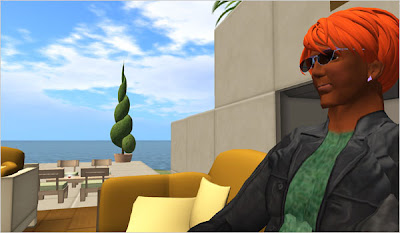The Job Interview, Starring Your Avatar

AS far as job interviews go, my recent meeting with Sandy Gould was anything but ordinary.
Mr. Gould showed up in a Superman costume. Next, he invited me to sit down next to him in a chaise longue that overlooked the crashing surf. As we talked about my strengths and weaknesses, crabs skittered along the sand at our feet. At another point, in the middle of responding to a question about overcoming professional challenges, I stood up and performed a hula dance.
Finally, after thanking me for my time, Mr. Gould stood up, shook my hand and flew away.
No, this wasn’t some technophile fantasy, nor was it my debut in local surrealist theater. Instead, Mr. Gould and I were sitting at computers on opposite sides of the same room. We were meeting in Second Life, the Web-based virtual world that is owned and operated by his employer, Linden Lab.
As big companies are spreading their brands to Web-based social networking communities like Facebook and MySpace, a handful of employers are also exploring the world of Multi-User Virtual Environments, or MUVEs.
Second Life is one of these MUVEs. A handful of corporate customers have bought virtual space, called “islands,” in this virtual reality to use for “in world” meetings, and a growing number in this group is recruiting there, too. Linden Lab doesn’t keep statistics on how many of its corporate customers handle hiring this way, but it says the number has grown exponentially since Second Life began in 2003.
Much of the recruitment is done through job fairs. TMP Worldwide Advertising & Communications, an advertising firm in New York, held two virtual job fairs last year, events that included employers like Hewlett-Packard, Microsoft, Verizon Communications and Sodexho, a food and facilities management services company. Bain & Company, the global management consultants in Boston, has sponsored virtual job fairs in Second Life, as well.
My interview was completely independent, an exercise I requested specifically to learn about the experience. Mr. Gould, director for recruiting and organizational development at Linden Lab, based in San Francisco, agreed to interview me the same way he does legitimate job candidates.
On the day of the interview, I started the process well before Mr. Gould had even arrived for work. After downloading Second Life software and registering for a free account, I chose a name for my avatar: Jaredpower Afarensis.
Within moments, the software took me to a virtual spot called Orientation Island, where I watched my avatar quite literally take shape: first his arms, then his legs, and finally his head.
Once my avatar materialized, a real-life friend of mine (a k a Lodro Goldkey) teleported him to another island and taught me how to get the avatar to blow kisses, bow, shake hands and hula dance. He also showed me how to make my virtual persona fly and sit down.
Next, I tackled my next challenge, personalizing my avatar. Second Life users can select hundreds of characteristics, like eye color, skin color, clothing and hairstyle. Users can also choose to make their avatars look like dragons, fairies, robots or even a bowl of Jell-O. I went for a human form, albeit one that was much larger than I am in real life.
Next, I chose the avatar’s attire: a white tank top, yellow pants and Birkenstock-like sandals. Finally, I was ready for the interview. I flew to the far side of the island and staked out a spot on a nearby beach. Like a bird or a plane, Mr. Gould (a k a Sandy Linden in our encounter) arrived out of nowhere. The interrogation began.
In a text-based chat window, he asked me about my thoughts on social networking technology and my opinion on the importance of virtual environments.
Later, I turned the questions on him, asking what he thought of the spot I had selected for our chat (“relaxing and calm,” he said, and “fantastic in the paradise sense”), and to what degree he thought the appearance of my avatar reflected how I really looked. (He hadn’t thought about it at all, save for my decision to dress casually.)
Over the course of 30 minutes, our conversation played out much like an instant-message chat I might have with friends: lots of text, a smattering of emoticons and furious typing, all without capitalization. When each of us typed in the chat boxes, our avatars would do nothing but look around.
AT one point — largely because of all of the attention I was paying to the chat box — Jaredpower Afarensis even appeared to slump over and go to sleep. So much of the interview revolved around the chat box that it seemed as if the avatars were barely there. That’s when it hit me: these newfangled Second Life job interviews might be fun, but they’re not exactly effective for everyone — at least not yet.
Granted, if I were a legitimate candidate applying for a job at Linden Lab, my ability to create the avatar and get him to the right place at the right time would have demonstrated a familiarity with Second Life.
Furthermore, if I were in a place like Iceland , an in-world interview might be cheaper and more efficient than flying so far away. But let’s say I was applying for a position as a chef or a lawyer. In these cases, 30 minutes in a Second Life interview would convey very little about my ability to do a job — besides a general affinity for technology.
When asked about these issues, Mr. Gould said that in most cases it’s best to use in-world interviews as one part of a recruitment process that also includes a combination of telephone interviews, videoconferences, e-mail exchanges or face-to-face meetings.
The question remains: With all of these other methods to evaluate a job candidate, do we really need another tool?
Comments